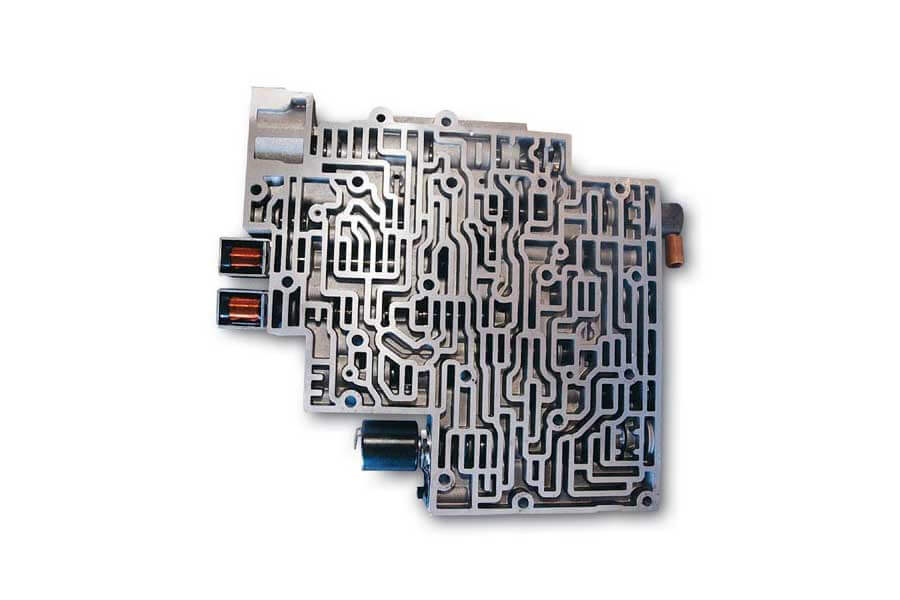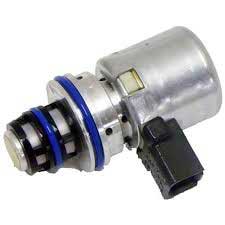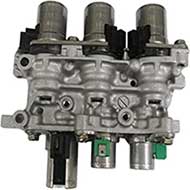
The valve body and its solenoids serve as the heart and brain of the automatic transmission. Why are they so important and unfortunately SO costly to repair or replace? Since the invention of the automatic transmission in 1921 and the first hydraulic transmission in 1932, manufacturers have worked to improve driver comfort, vehicle performance, and gas mileage. The latter, fuel economy, has become increasingly important in recent years due to environmental concerns. As a result, automatic transmissions have undergone great changes and have become incredibly complex systems. While older transmissions had 2, 3 or 4 speeds or “gears,” modern automatics have seen 10 speeds or more along with multiple reverse gears. Modern electronic systems monitor performance and control the transmission while driving. The valve body and solenoids play a central role in the operations of these modern transmissions, which we will look at in greater detail.
The Valve Body
The valve body acts as the control center of the automatic transmission. Usually made of aluminum (Fun Fact: valve bodies in much older vehicles were cast iron allowing for greater durability yet the weight hindered fuel economy), it contains a maze of channels and passages that direct the transmission fluid through valves to control the various clutches, bands and drums that change gears.
Vehicles have a number of sensors that are monitoring vehicle speed, engine load and throttle position and send this information to an onboard computer, which in turn communicates with the valve body in order to shift up and down between gears. When a shift is needed, valves open and close to direct transmission fluid to the appropriate area to make the gear change occur. Transmission fluid, unlike motor oil, is more than just a lubricating fluid; it’s a hydraulic fluid. The transmission fluid flowing through the valve body is under tremendous pressure, which in turn generates heat. As the soft parts in the transmission break down, they leave small particles in the fluid as contaminants, which becomes abrasive.
This combination of pressure, heat, water intrusion and abrasion has a negative impact on the valve body over time. The valves will wear down, the channels can be abraded and become oversized, and the whole valve body unit can become warped. Signs of a bad valve body can be fluid leaks, slipping during gear changes, or even failure to go into gear.
Transmission Specifics:
Nissan has sold millions of dollars of RE5 valve bodies because of a faulty radiator. These units are found in Nissan Xterra, Nissan Pathfinder and Nissan Frontier models. A poor design causes a breach in the radiator causing coolant (glycol or radiator fluid) to sneak into the transmission coolers lines and ultimately cause water contamination in the transmission. The biggest downside to this scenario that motivated a national class action suit against Nissan is the rust that forms on the valve body that prevents the proper operations of valves. Once contaminated, there’s no turning back unless the valve body is replaced, among other items required in a quality transmission rebuild.
Transmission Solenoids
A solenoid is basically an electro-hydraulic switch that controls the valves in the valve body. Information from a vehicle’s computer opens and closes these switches in order to control the flow of transmission fluid and therefore the function of the transmission. Solenoids control torque converter lockup, internal transmission pressure, and shifting. As modern transmissions have become more complex, especially with electronic complexity, the number of solenoids has gone up as well. Older 4 speed transmissions may have only 2 or 3 solenoids, while some new 8 and 10 speed transmissions may have 13 or more!
Additionally, solenoids themselves have become more sophisticated. Older designs are simply binary in that they are either “on” or “off” – it’s a switch. Newer designs are often “pulse width modulated” or “variable force” solenoids. These allow the computer to adjust timing and volume of the valve opening and closing to maximize fuel efficiency and performance. Depending on manufacturer and design, these solenoids can be inside of the transmission or mounted on the outside of the housing. All in all, transmissions have become less and less dependent on mechanical and hydraulic systems and more dependent on computers and electronic controls.
Transmission specifics: Commonly found in models such as the Silverado, Suburban, Tahoe or Denali, the GM 4L60E was originally designed with a simple binary TCC (torque converter clutch) solenoid. However, the abrupt “on-off” function caused a number of premature failures in these units, leading GM to incorporate a “pulse width modulated” solenoid. This allowed a gradual lockup of the torque converter and reduced these premature failures.
The downside is that electronic components can and will fail. A solenoid can stick open or stick closed, or simply become erratic and inconsistent. When this happens, transmission problems can show up rapidly. Too much internal pressure can cause hard shifts, while too little pressure will rob the transmission of fluid causing overheating that will destroy clutch packs. A bad solenoid can cause delays in shifting, or even shifting into the wrong gear or shifting up and down unpredictably. A bad solenoid often signals an error to the computer and a “check engine” light will come on.
Transmission Specifics:
The Dodge 42RE/47RE/48RE transmission series have a history of problems with the transducer and pressure solenoids. When a solenoid is charged, it becomes magnetic. The solenoids in these Dodge transmissions are notorious for picking up metallic particles quickly and behaving erratically, causing delayed and or missed shifts. Identifying the problem and addressing it quickly can save a lot of headaches!
Fixing the Problem
If your transmission’s valve body has become worn or damaged, this will usually require a proper rebuild of the transmission to repair. Occasionally this will involve simply rebuilding or replacing the valve body, but this is usually a shortcut that will lead to more problems. A bad valve body is usually a sign that there is more damage inside of the transmission, and a transmission expert needs to fully disassemble and inspect the entire transmission to ensure that everything is up to the manufacturer’s specifications. A transmission is filled with wearable components such as gaskets, seals and clutches that will deteriorate over time. Why spend money on a valve body repair when the “soft parts” have significant wear and can give out anytime?
With a bad solenoid, repairs can often be more straightforward, especially if the vehicle mileage is low and the application is not heavy duty. Assuming a solenoid failure is caught early enough, before too much damage has been done, a replacement of the bad switch can often resolve the transmission malfunction. That full rebuild for several thousand dollars that you feared might be taken care of for a few hundred dollars instead! However, it is best to have a full diagnosis performed by a transmission shop to determine the best course of action to get your vehicle up and running again. This is where an honest local transmission shop is important to program into your speed dial!
Transmission Specifics:
Dodge-Chrysler vehicles, especially Ram trucks or Jeeps, carry a 545RFE transmission that integrates its solenoids into a single block of numerous solenoids. Erratic shifting on these units is a typical problem and often can be tracked to a malfunctioning solenoid within the block. Unfortunately, these situations are not limited to high mileage situations. In low mileage situations, the solenoid block alone can be replaced saving a customer thousands of dollars required for a full transmission rebuild.
Transmission Rebuild & Repair Experts
The Advanced Transmission Center team consists of technicians who have decades of experience diagnosing, rebuilding and repairing automatic transmissions in domestic and import vehicles. We have the ability to test and diagnose problems with your valve body or your transmission solenoids and use only quality parts in our repairs.
If you are having problems with your valve body, solenoids, or any transmission related issue, contact Advanced Transmission Center at either of our shop locations and we’d be happy to help! Unlike dealerships or many independent repair shops, we are transmission specialists trained to fix issues related to a vehicle drive-train. You can reach out to either location that is most convenient for you.
Advanced Transmission Center is a Colorado-owned and operated auto repair shop with locations in Denver / Lakewood and Westminster. ATC specializes in driveline issues such as automatic transmission repair, four wheel drive repair, clutch replacement, differentials, manual transmissions and CVT. As Colorado's first AAA approved shop our goal is to provide accurate, timely service with exceptional customer satisfaction. All of our technicians are certified in the latest makes and models and we are one of the few transmission repair shops with a nationwide warranty.





 Free Customer Towing Service
Free Customer Towing Service  Free TrueTest™ Inspection
Free TrueTest™ Inspection  Fast Transmission Services
Fast Transmission Services  Comprehensive Warranty in Denver
Comprehensive Warranty in Denver 

























